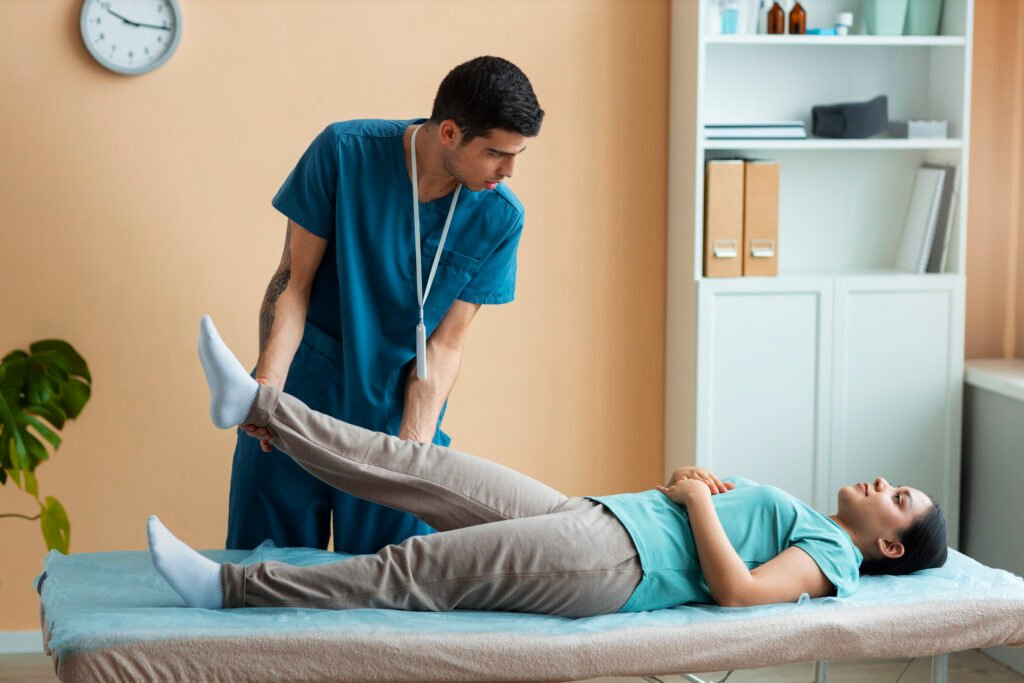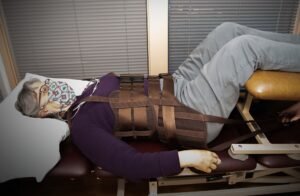Lumbar traction is a therapeutic technique used in the field of physical therapy to address various conditions affecting the lower back and spine. This non-invasive procedure involves the application of mechanical force to the lumbar spine in order to create separation between vertebrae, reduce pressure on spinal discs, and alleviate compression on nerve roots. The goal of lumbar traction is to relieve pain, improve mobility, and promote the overall health of the lumbar region. There are two main types of lumbar traction: manual traction, where a therapist applies force with their hands, and mechanical traction, which involves the use of specialized devices or equipment.

The treatment is often customized based on the patient’s specific condition, and it is commonly employed for conditions such as herniated discs, sciatica, and degenerative disc disease. Lumbar traction is typically administered under the guidance of a trained healthcare professional and is part of a comprehensive treatment plan that may include exercises, stretches, and other therapeutic modalities to enhance its effectiveness.
Benifit of Lumbar traction
 The benefits of lumbar traction are manifold, particularly for individuals experiencing lower back pain or related spinal conditions. One primary advantage is the potential to relieve pressure on the intervertebral discs, promoting the redistribution of fluids and nutrients within the spinal discs. This can help alleviate pain associated with conditions such as herniated discs or degenerative disc disease. Lumbar traction also aids in the decompression of spinal nerve roots, reducing compression and promoting better nerve function. By creating space between vertebrae, this therapeutic technique can improve spinal alignment and mobility, contributing to enhanced flexibility and a reduction in stiffness.
The benefits of lumbar traction are manifold, particularly for individuals experiencing lower back pain or related spinal conditions. One primary advantage is the potential to relieve pressure on the intervertebral discs, promoting the redistribution of fluids and nutrients within the spinal discs. This can help alleviate pain associated with conditions such as herniated discs or degenerative disc disease. Lumbar traction also aids in the decompression of spinal nerve roots, reducing compression and promoting better nerve function. By creating space between vertebrae, this therapeutic technique can improve spinal alignment and mobility, contributing to enhanced flexibility and a reduction in stiffness.
Additionally, lumbar traction can be beneficial in promoting the healing process by increasing blood flow to the affected area. This non-invasive approach to managing lower back issues is often considered a valuable component of comprehensive treatment plans, providing patients with relief from pain, improved functionality, and a potential pathway to long-term spinal health. It is important, however, for individuals to consult with healthcare professionals to determine the appropriateness of lumbar traction for their specific conditions and to ensure proper administration under trained supervision.
Lumbar traction F&Q's
Lumbar traction is a therapeutic technique used in physical therapy to address lower back and spinal conditions. It involves applying mechanical force to the lumbar spine to create separation between vertebrae, reduce pressure on spinal discs, and alleviate compression on nerve roots.
There are two main types of lumbar traction: manual traction, where a therapist applies force with their hands, and mechanical traction, which involves the use of specialized devices or equipment.
Lumbar traction is commonly used for conditions such as herniated discs, sciatica, and degenerative disc disease. It aims to relieve pain, improve mobility, and promote overall lumbar health.
Lumbar traction provides several benefits, including the potential to relieve pressure on intervertebral discs, promote the redistribution of fluids and nutrients within the spine, decompress spinal nerve roots, improve spinal alignment and mobility, and increase blood flow to the affected area.
Lumbar traction is typically part of a comprehensive treatment plan that may include exercises, stretches, and other therapeutic modalities. It is often customized based on the patient’s specific condition and is administered under the guidance of a trained healthcare professional.
Individuals should consult with healthcare professionals to determine the appropriateness of lumbar traction for their specific conditions. It is crucial to ensure proper administration under trained supervision to maximize the benefits and minimize any potential risks.
